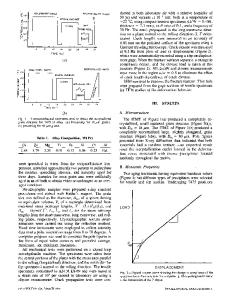The effect of particulate SiC on fatigue crack growth in a cast-extruded aluminum alloy composite
- PDF / 4,209,843 Bytes
- 16 Pages / 597.6 x 774 pts Page_size
- 84 Downloads / 327 Views
I.
INTRODUCTION
THE addition of silicon carbide particles to aluminum alloys results in an increased modulus, which may also be accompanied by an increased yield stress, depending on the alloy, heat treatment, and manufacturing methodY] Other attributes for these composites may be enhanced resistance to wear, [2] corrosion,P] and fatigue crack initiation[3] when compared to the matrix materials alone. Unfortunately, the fracture resistance of these composites is usually lower than for unreinforced aluminum alloys. [4.5] Why is the crack growth resistance of this class of composites inferior to aluminum alloys and what can be done to enhance the composite fracture properties? The research reported here has used crack-tip micromechanics in addition to more traditional methods to gain insight into the origins of fracture characteristics of one of these materials. Several manufacturing methods have been used to produce particulate aluminum alloy composites. The material studied in the present research was manufactured by dispersing silicon carbide powder into molten aluminum alloy which was then cast and further worked by extrusion. This is one of the simplest and least expensive methods for manufacturing these composites. The general fracture characteristics of this class of composites have been determined and published,[4-8] but for the cast and extruded material, no detailed work has been published. The research reported here concentrates on a study of fatigue fracture for one of the cast-extruded materials which exhibited a superior fracture toughness to a number of other materials tested.[4] This research complements that previously published for a composite manufactured by mechanical alloying[9] and is companion to other research[IO] to be published which will report on the micromechanics of tensile deformation and fracture toughness of this same material.
DAVID L. DAVIDSON. Institute Scientist. is with Southwest Research Institute, P.O. Box 28510, San Antonio, TX 78228-0510. Manuscript submitted April 17, 1990. METALLURGICAL TRANSACTIONS A
II.
MATERIAL
The material investigated was fabricated in 1985 by Science Applications International of San Diego, CA, now called the Dural Aluminum Composites Company, a subsidiary of Alcan. Particulate SiC at a concentration of 15 pct by volume was dispersed in 2014 aluminum alloy (4.4Cu, 0.8Si, 0.8Mn, O.4Mg in wt pct) using a proprietary method. After casting, the material was extruded at 450°C with a 8.2: 1 ratio to produce bars of 16 x 38-mm cross section. Upon receipt of the material, half of it was cut into pieces about 60-mm long, solutionized at 500°C for 2 hours, and precipitation aged to peak hardness (T6) at 160°C for 16 hours, according to the recommendations of the manufacturer (which is not the standard age hardening treatment for the unreinforced 2014 alloy). For comparison to other composites tested,[4,5] this material was designated 20l4-PA + 15 vol pct SiC. This material composition and heat treatment gave the highest value of fracture toughness measure
Data Loading...











